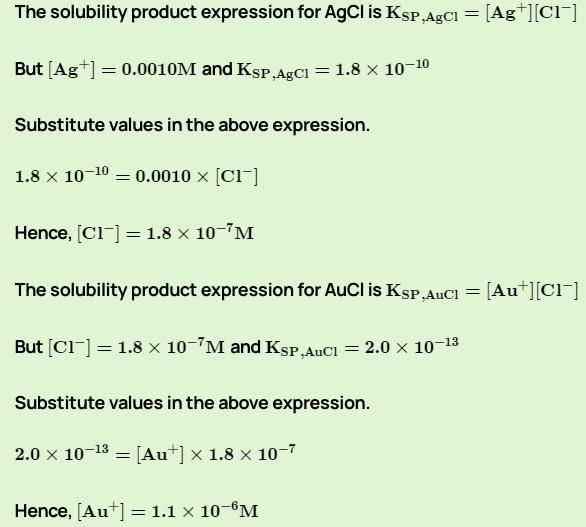All Exams >
EmSAT Achieve >
Chemistry for EmSAT Achieve >
All Questions
All questions of Chemical Equilibrium for EmSAT Achieve Exam
Ca(HCO3)2 is strongly heated and after equilibrium is attained, temperature changed to 25° C.

Kp = 36 (pressure taken in atm)
Thus, pressure set up due to CO2 is- a)36 atm
- b)18 atm
- c)12 atm
- d)6 atm
Correct answer is 'D'. Can you explain this answer?
Ca(HCO3)2 is strongly heated and after equilibrium is attained, temperature changed to 25° C.

Kp = 36 (pressure taken in atm)
Thus, pressure set up due to CO2 is
Kp = 36 (pressure taken in atm)
Thus, pressure set up due to CO2 is
a)
36 atm
b)
18 atm
c)
12 atm
d)
6 atm
|
|
Mira Joshi answered |
The reaction is as follow:-
Ca(HCO3)2(s)⇌CaO(s) + 2CO2 (g) + H2O(g)
At 25° C H2O goes in liquid state
Kp = (PCaO)1×(PCO2)2
(PCa(HCO3)2)
Since, Ca(HCO3)2, CaO and H2O are not in gaseous state, so their partial pressure is taken 1.
Putting all values, we have
36 = (PCO2)2
Or PCO2 = 6 atm
Ca(HCO3)2(s)⇌CaO(s) + 2CO2 (g) + H2O(g)
At 25° C H2O goes in liquid state
Kp = (PCaO)1×(PCO2)2
(PCa(HCO3)2)
Since, Ca(HCO3)2, CaO and H2O are not in gaseous state, so their partial pressure is taken 1.
Putting all values, we have
36 = (PCO2)2
Or PCO2 = 6 atm
Rate of reaction is proportional to product of molar concentration of reactants with each concentration term raised to power its stoichiometric coefficient. This is the law of- a)Equilibrium
- b)Mass action
- c)Constant proportion
- d)Reciprocal proportions
Correct answer is option 'B'. Can you explain this answer?
Rate of reaction is proportional to product of molar concentration of reactants with each concentration term raised to power its stoichiometric coefficient. This is the law of
a)
Equilibrium
b)
Mass action
c)
Constant proportion
d)
Reciprocal proportions
|
|
Preeti Iyer answered |
Law of mass action states that the rate of reaction is proportional to the product of molar concentration of reactant with each concentration term raised to power its stoichiometric coefficient.
Consider the following equilibrium in a closed container
 At a fixed temperature, the volume of a reaction container is halved. For this change, which of the following statements holds true regarding the equilibrium constant (Kp) and degree of dissociation (α) ?
At a fixed temperature, the volume of a reaction container is halved. For this change, which of the following statements holds true regarding the equilibrium constant (Kp) and degree of dissociation (α) ?- a)Neither Kp nor α change
- b)Both Kp and α change
- c)Kp changes but α does not change
- d)Kp does not change but α changes
Correct answer is option 'D'. Can you explain this answer?
Consider the following equilibrium in a closed container

At a fixed temperature, the volume of a reaction container is halved. For this change, which of the following statements holds true regarding the equilibrium constant (Kp) and degree of dissociation (α) ?
a)
Neither Kp nor α change
b)
Both Kp and α change
c)
Kp changes but α does not change
d)
Kp does not change but α changes
|
|
Geetika Shah answered |
We know that Kp depends only on Temperature. As the temp. remains constant , Kp also remains constant.
α depends on the concentration of the reactant
So as the volume of the reaction container is halved, α also changes
So option d is correct.
α depends on the concentration of the reactant
So as the volume of the reaction container is halved, α also changes
So option d is correct.
Following equilibrium is set up at 298 K in a 1 L flask.

If one starts with 2 moles of A and 1 mole of B, it is found that moles of B and D are equal.Thus Kc is - a)9.0
- b)15.0
- c)3.0
- d)0.0667
Correct answer is option 'B'. Can you explain this answer?
Following equilibrium is set up at 298 K in a 1 L flask.

If one starts with 2 moles of A and 1 mole of B, it is found that moles of B and D are equal.Thus Kc is
If one starts with 2 moles of A and 1 mole of B, it is found that moles of B and D are equal.Thus Kc is
a)
9.0
b)
15.0
c)
3.0
d)
0.0667

|
Sushil Kumar answered |
For the equilibrium reaction:
A+2B ⇌ 2C+D
volume of flask = 1L
Initial moles of A = 2 mol
initial concentration of A=[A]i = 2 M
initial mole of B = 1 mol
[B]i = 1 M
[A]eq = 2-x, [B]eq = 1-2x, [C]eq = x, [D]eq = 3x
Given [D]eq = 1 * 1L
= 1 M
Thus x = 1M
[A]eq = 1, [B]eq = -1, [C]eq = 1, [D] = 3
Kc = {([D]eq)3 * ([C]eq)}/{[A]eq * ([B]eq)2}
= Kc = {(3)3*1}/{1*(-1)2}
= 27/1
= 27
A+2B ⇌ 2C+D
volume of flask = 1L
Initial moles of A = 2 mol
initial concentration of A=[A]i = 2 M
initial mole of B = 1 mol
[B]i = 1 M
[A]eq = 2-x, [B]eq = 1-2x, [C]eq = x, [D]eq = 3x
Given [D]eq = 1 * 1L
= 1 M
Thus x = 1M
[A]eq = 1, [B]eq = -1, [C]eq = 1, [D] = 3
Kc = {([D]eq)3 * ([C]eq)}/{[A]eq * ([B]eq)2}
= Kc = {(3)3*1}/{1*(-1)2}
= 27/1
= 27
Which of the following is not a general characteristic of equilibria involving physical processes?- a)Equilibrium is possible only in a closed system at a given temperature.
- b)All measurable properties of the system remain constant.
- c)All the physical processes stop at equilibrium.
- d)The opposing processes occur at the same rate and there is dynamic but stable condition.
Correct answer is option 'C'. Can you explain this answer?
Which of the following is not a general characteristic of equilibria involving physical processes?
a)
Equilibrium is possible only in a closed system at a given temperature.
b)
All measurable properties of the system remain constant.
c)
All the physical processes stop at equilibrium.
d)
The opposing processes occur at the same rate and there is dynamic but stable condition.
|
|
Mira Sharma answered |
All the physical processes like melting of ice and freezing of water, etc., do not stop at equilibrium.
Ag+(aq)+NH3(aq)  [Ag(NH3)(aq)]+ ; K, = 3.5x 10-3
[Ag(NH3)(aq)]+ ; K, = 3.5x 10-3
[Ag(NH3)]+ (aq)+NH3(aq)  [Ag(NH3)2]2+(aq); K2 = 1.7x 10-3
[Ag(NH3)2]2+(aq); K2 = 1.7x 10-3
Formation constant of [Ag(NH3)2]+(aq) is- a)2.06
- b)5.2 x 10-3
- c)5.95 x 10-6
- d)None of these
Correct answer is option 'C'. Can you explain this answer?
Ag+(aq)+NH3(aq)  [Ag(NH3)(aq)]+ ; K, = 3.5x 10-3
[Ag(NH3)(aq)]+ ; K, = 3.5x 10-3
[Ag(NH3)]+ (aq)+NH3(aq) [Ag(NH3)2]2+(aq); K2 = 1.7x 10-3
[Ag(NH3)2]2+(aq); K2 = 1.7x 10-3
Formation constant of [Ag(NH3)2]+(aq) is
[Ag(NH3)]+ (aq)+NH3(aq)
Formation constant of [Ag(NH3)2]+(aq) is
a)
2.06
b)
5.2 x 10-3
c)
5.95 x 10-6
d)
None of these
|
|
Krishna Iyer answered |
The correct answer is Option C.
To get the formation constant add both reactions-
So the resultant K = K1 × K2
= 3.5×1.7×10−3
= 5.95×10−6
To get the formation constant add both reactions-
So the resultant K = K1 × K2
= 3.5×1.7×10−3
= 5.95×10−6
Graphite is added to a vessel that contains CO2(g) at a pressure of 0.830 atm at a certain high temperature. The pressure rises due to a reaction that produces CO (g). The total pressure reaches an equilibrium value of 1.366 atm. Calculate the equilibrium constant of the following reaction.

- a)2.909 atm
- b)6.909 atm
- c)4.909 atm
- d)3.909 atm
Correct answer is option 'D'. Can you explain this answer?
Graphite is added to a vessel that contains CO2(g) at a pressure of 0.830 atm at a certain high temperature. The pressure rises due to a reaction that produces CO (g). The total pressure reaches an equilibrium value of 1.366 atm. Calculate the equilibrium constant of the following reaction.

a)
2.909 atm
b)
6.909 atm
c)
4.909 atm
d)
3.909 atm
|
|
Hansa Sharma answered |
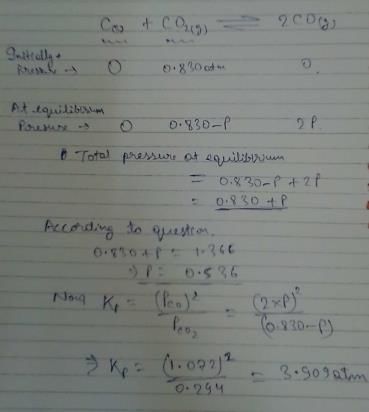
In which of the following reaction can equilibrium be attained- a)Reversible reaction
- b)Cyclic reaction
- c)Decomposition reaction
- d)Irreversible reaction
Correct answer is option 'A'. Can you explain this answer?
In which of the following reaction can equilibrium be attained
a)
Reversible reaction
b)
Cyclic reaction
c)
Decomposition reaction
d)
Irreversible reaction
|
|
Rajat Kapoor answered |
Reversible Reaction
The common observation for any reactions when they are reacted in closed containers would not go to completion, for some given conditions like temperature and pressure.
For all those cases, only the reactants are found to be present in the intial stages, but with the progress of reaction, the reactants concentration decreases and to that of the products increases. A stage is finally reached where there is no more change of reactants and products concentration is observed. The state where the reactants and products concentrations do not show any visible change within a given period of time is better known as the state of chemical equilibrium.
The reactant amount that remains unused depends upon the experimental conditions like concentration of components, temperature of the system, pressure of the system and the reaction nature.
Direction (Q. Nos. 1-10) This section contains 10 multiple choice questions. Each question has four
choices (a), (b), (c) and (d), out of which ONLY ONE option is correct.Q. Vapour pressure of NH4HS (s)is 20 mm at 25°C, for

Total pressure when NH4HS (s) dissociates at 25°Cin a vessel which already contains H2S (g)at a pressure of 15 mm, is- a)25 mm
- b)50 mm
- c)5 mm
- d)10 mm
Correct answer is option 'A'. Can you explain this answer?
Direction (Q. Nos. 1-10) This section contains 10 multiple choice questions. Each question has four
choices (a), (b), (c) and (d), out of which ONLY ONE option is correct.
choices (a), (b), (c) and (d), out of which ONLY ONE option is correct.
Q. Vapour pressure of NH4HS (s)is 20 mm at 25°C, for

Total pressure when NH4HS (s) dissociates at 25°Cin a vessel which already contains H2S (g)at a pressure of 15 mm, is
Total pressure when NH4HS (s) dissociates at 25°Cin a vessel which already contains H2S (g)at a pressure of 15 mm, is
a)
25 mm
b)
50 mm
c)
5 mm
d)
10 mm
|
|
Hansa Sharma answered |
The correct answer is Option A.
NH4HS -------> NH3 + H2S
Let P be the pressure at eq. of NH3 and H2S.
Therefore, Kp = P2
= (20 / 2)2
= 100 mm
= 100
Also, Kp = (15 + P) (P)
100 = 15 P + P2
P2 + 15 P – 100 = 0
P = 5
Total pressure = 15 + 2(P)
= 15 + 2(5)
= 25 mm
NH4HS -------> NH3 + H2S
Let P be the pressure at eq. of NH3 and H2S.
Therefore, Kp = P2
= (20 / 2)2
= 100 mm
= 100
Also, Kp = (15 + P) (P)
100 = 15 P + P2
P2 + 15 P – 100 = 0
P = 5
Total pressure = 15 + 2(P)
= 15 + 2(5)
= 25 mm
Following equilibrium is set up at 1000 K and 1 bar in a 5 L flask,

At equilibrium, NO2 is 50% o f the total volume. Thus, equilibrium constant Kc is - a)0.133
- b)0.266
- c)0.200
- d)0.400
Correct answer is option 'A'. Can you explain this answer?
Following equilibrium is set up at 1000 K and 1 bar in a 5 L flask,

At equilibrium, NO2 is 50% o f the total volume. Thus, equilibrium constant Kc is
At equilibrium, NO2 is 50% o f the total volume. Thus, equilibrium constant Kc is
a)
0.133
b)
0.266
c)
0.200
d)
0.400

|
Manish Aggarwal answered |
The correct answer is Option A.
N2O4 ⇌ 2NO2
Initial 1 0
Equilibrium 1−x 2x
N2O4 ⇌ 2NO2
Initial 1 0
Equilibrium 1−x 2x
Total moles = 1 - x + 2x
NO2 is 50% of the total volume when equilibrium is set up.
Thus, the volume fraction (at equilibrium) of NO2 = 50/100 = 0.5 = ½
So, 2x / (1+x) = ½
=> x = ⅓
Thus, the volume fraction (at equilibrium) of NO2 = 50/100 = 0.5 = ½
So, 2x / (1+x) = ½
=> x = ⅓
For 1 litre;
Kc = [NO2] / [N2O4]
= [4*(1/9)] / [⅔]
= 0.66;
Kc = [NO2] / [N2O4]
= [4*(1/9)] / [⅔]
= 0.66;
For 5 litres;
Kc = 0.66 / 5
= 0.133
Thus, option A is correct.
Kc = 0.66 / 5
= 0.133
Thus, option A is correct.
 Q. What is [PCI5] eq?
Q. What is [PCI5] eq?- a)4.09 x 10-4 mol L-1
- b)2.444 x 103 mol L-1
- c)4.09 x 10-6 mol L-1
- d)2.444 x 105 mol L-1
Correct answer is option 'A'. Can you explain this answer?
Q. What is [PCI5] eq?
a)
4.09 x 10-4 mol L-1
b)
2.444 x 103 mol L-1
c)
4.09 x 10-6 mol L-1
d)
2.444 x 105 mol L-1
|
|
Riya Banerjee answered |
The correct answer is Option A.
PPCl3 = [PCl3]RT
PCl2 = [Cl2]RT
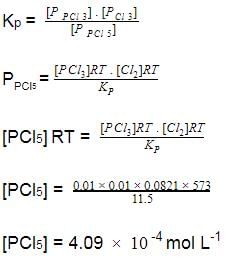
PPCl3 = [PCl3]RT
PCl2 = [Cl2]RT

Passage IIThe complex ion of Fe2+ with the chelating agent dipyridyl (abbreviated dipy) has been studied kinetically in both the forward and backward directions. For the complexion reaction,
the rate of the formation of the complex at 298 K is given by rate = (1. 45 x 1013 L3mol -3s-1) [Fe 2+] [dipy]3 and for the reverse reaction , the rate of disapperance of the complex is
 Q. What is equilibrium constant for the equilibrium ?
Q. What is equilibrium constant for the equilibrium ? 
- a)8.4138x 10-18
- b)2.3770x 1017
- c)1.1885x 1017
- d)5.9426x 106
Correct answer is option 'C'. Can you explain this answer?
Passage II
The complex ion of Fe2+ with the chelating agent dipyridyl (abbreviated dipy) has been studied kinetically in both the forward and backward directions. For the complexion reaction,
the rate of the formation of the complex at 298 K is given by rate = (1. 45 x 1013 L3mol -3s-1) [Fe 2+] [dipy]3 and for the reverse reaction , the rate of disapperance of the complex is
Q. What is equilibrium constant for the equilibrium ?
a)
8.4138x 10-18
b)
2.3770x 1017
c)
1.1885x 1017
d)
5.9426x 106
|
|
Suresh Iyer answered |
The correct answer is Option C.
Fe2+ + 3 dipy -----> Fe(dipy)32+
Rf = Kf [Fe2+] [dipy]3
Rb = Kb [Fe(dipy)32+]
Keq = Kb [Fe(dipy)32+] / Kf [Fe2+] [dipy]3
Rf = Rb
Keq = Kf / Kb
= 1. 45 x 1013 / 1.24 x 10-4
= 1.885 x 1017
Fe2+ + 3 dipy -----> Fe(dipy)32+
Rf = Kf [Fe2+] [dipy]3
Rb = Kb [Fe(dipy)32+]
Keq = Kb [Fe(dipy)32+] / Kf [Fe2+] [dipy]3
Rf = Rb
Keq = Kf / Kb
= 1. 45 x 1013 / 1.24 x 10-4
= 1.885 x 1017
Assume following equilibria when total pressure set up in each are equal to 1 atm, and equilibrium constant (Kp) as K1; K2 and K3


Thus,- a) K1 = K2 = K3
- b)K1 < K2 < K3
- c)K3 < K2 < K1
- d)None of these
Correct answer is option 'C'. Can you explain this answer?
Assume following equilibria when total pressure set up in each are equal to 1 atm, and equilibrium constant (Kp) as K1; K2 and K3


Thus,
Thus,
a)
K1 = K2 = K3
b)
K1 < K2 < K3
c)
K3 < K2 < K1
d)
None of these

|
Pioneer Academy answered |
The correct answer is option C
CaCO3 → CaO + CO2
Kp = k1 = Pco2
total pressure of container P
k1 = p
NH4HS → NH3 + H2S
PNH3 = PH2S = P0
P0 + P0 = p (total pressure)
P0 = p/2
k2 = kp = [PNH3][PH2s] p24
NH2CoNH2 → 2NH3 + CO2
PNH3 = 2P0 PCO2 = P0
2P0 + P0 = P
CaCO3 → CaO + CO2
Kp = k1 = Pco2
total pressure of container P
k1 = p
NH4HS → NH3 + H2S
PNH3 = PH2S = P0
P0 + P0 = p (total pressure)
P0 = p/2
k2 = kp = [PNH3][PH2s] p24
NH2CoNH2 → 2NH3 + CO2
PNH3 = 2P0 PCO2 = P0
2P0 + P0 = P
At 1000 K, pressure of CO2 in equilibrium with CaCO3 and CaO is equal to 2.105 atm. The equilibrium constant for the reaction,

is 1.9 at the same temperature when pressure are in atm. Solid C, CaO, and CaCO3 are mixed and allowed to come to equilibrium at 1000 K in a closed vessel.Q. What is the pressure of CO (g)at equilibrium (in atm)?
Correct answer is '2'. Can you explain this answer?
At 1000 K, pressure of CO2 in equilibrium with CaCO3 and CaO is equal to 2.105 atm. The equilibrium constant for the reaction,

is 1.9 at the same temperature when pressure are in atm. Solid C, CaO, and CaCO3 are mixed and allowed to come to equilibrium at 1000 K in a closed vessel.
is 1.9 at the same temperature when pressure are in atm. Solid C, CaO, and CaCO3 are mixed and allowed to come to equilibrium at 1000 K in a closed vessel.
Q. What is the pressure of CO (g)at equilibrium (in atm)?

|
Learners Habitat answered |
K= (partial pressure of co2/(partial pressure of co2)
since k =1.9
So 1.9 = (partial pressure of co)2/2.105
(partial pressure of co)2 =2.105×1.9
= 3.99 = 4
(partial pressure of co) =2
since k =1.9
So 1.9 = (partial pressure of co)2/2.105
(partial pressure of co)2 =2.105×1.9
= 3.99 = 4
(partial pressure of co) =2
Ca(HCO3)2 decomposes as,
Ca (HCO3)2(s) ⇌ CaCO3(s) + H2O(g) + CO2(g)
Equilibrium pressure is found to be 0.12 bar. What is pco2 if the reaction mixture also contains H2O(g)at 0.20 bar?
- a) 0.20 bar
- b) 0.017 ba
- c)0.040 bar
- d)0.10 bar
Correct answer is option 'B'. Can you explain this answer?
Ca(HCO3)2 decomposes as,
Ca (HCO3)2(s) ⇌ CaCO3(s) + H2O(g) + CO2(g)
Equilibrium pressure is found to be 0.12 bar. What is pco2 if the reaction mixture also contains H2O(g)at 0.20 bar?
Equilibrium pressure is found to be 0.12 bar. What is pco2 if the reaction mixture also contains H2O(g)at 0.20 bar?
a)
0.20 bar
b)
0.017 ba
c)
0.040 bar
d)
0.10 bar

|
Top Rankers answered |
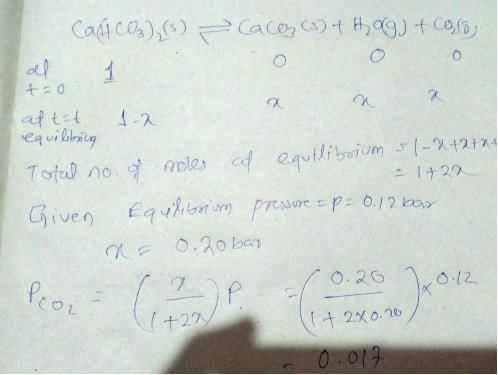
For HF, pKa = 3.45. What is the pH of an aqueous buffer solution that is 0.1M HF (aq) and 0.300 M KF (aq)?
a)11.03b)2.97c)10.07d)3.93 Correct answer is option 'D'. Can you explain this answer?
|
|
Suresh Iyer answered |
Given, pKa = 3.45
Concentration of HF = 0.1 M, concentration of KF = 0.300 M
For acidic buffer;
pH = pKa + log [salt of weak acid]/[weak acid]
= 3.45 + log0.3/0.1
= 3.45 + 0.48
= 3.93
Concentration of HF = 0.1 M, concentration of KF = 0.300 M
For acidic buffer;
pH = pKa + log [salt of weak acid]/[weak acid]
= 3.45 + log0.3/0.1
= 3.45 + 0.48
= 3.93
H2O (l)  H2O(s) ; ΔH = -qApplication of pressure on this equilibrium
H2O(s) ; ΔH = -qApplication of pressure on this equilibrium- a)cause formation of more ice
- b)cause fusion of ice
- c)has no effect
- d)lower the melting point
Correct answer is option 'B,D'. Can you explain this answer?
H2O (l)  H2O(s) ; ΔH = -q
H2O(s) ; ΔH = -q
 H2O(s) ; ΔH = -q
H2O(s) ; ΔH = -qApplication of pressure on this equilibrium
a)
cause formation of more ice
b)
cause fusion of ice
c)
has no effect
d)
lower the melting point
|
|
Krishna Iyer answered |
The correct answers are Options B and D.
As we know that reaction is exothermic it means heat is released in the reaction so, if we apply pressure then reaction will proceed in backward direction but if there is gas phase equilibrium the reaction will shift in that direction in which less number of moles are present. If pressure increases then the ice will melt and ice gets more energy at low temp. To melt ,so it’s melting point decreases.
As we know that reaction is exothermic it means heat is released in the reaction so, if we apply pressure then reaction will proceed in backward direction but if there is gas phase equilibrium the reaction will shift in that direction in which less number of moles are present. If pressure increases then the ice will melt and ice gets more energy at low temp. To melt ,so it’s melting point decreases.
The equilibrium constant for the following reaction, is 1.6 x 105 at 1024 K.
HBr (g)at 10.0 bar is introduced into a sealed container at 1024 K. Thus, partial pressure of H2(g)and Br2(g), together is- a)10 bar
- b)0.05 bar
- c)0.025 bar
- d)0.10 bar
Correct answer is option 'A'. Can you explain this answer?
The equilibrium constant for the following reaction, is 1.6 x 105 at 1024 K.
HBr (g)at 10.0 bar is introduced into a sealed container at 1024 K. Thus, partial pressure of H2(g)and Br2(g), together is
a)
10 bar
b)
0.05 bar
c)
0.025 bar
d)
0.10 bar
|
|
Rahul Bansal answered |
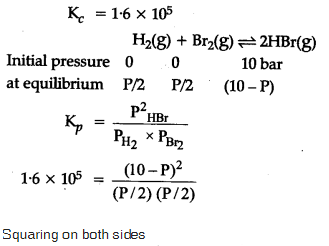
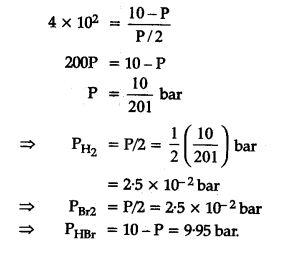
=> 10 bar approximately
. What is the molar solubility (s) of Ba3(PO4)2 in terms of Ksp?- a)s = [Ksp/27]1/5
- b)s = Ksp1/5
- c)s = Ksp1/2
- d)s = [Ksp/108]1/5
Correct answer is option 'D'. Can you explain this answer?
. What is the molar solubility (s) of Ba3(PO4)2 in terms of Ksp?
a)
s = [Ksp/27]1/5
b)
s = Ksp1/5
c)
s = Ksp1/2
d)
s = [Ksp/108]1/5

|
Mohit Rajpoot answered |
Ba3(PO4)2 ⇌ 3Ba+2 (2PO4)-3

Ksp = [Ba+2>]3 [(PO4)-3]2
[3s]3[2s]2
Ksp = 108s5
Or s = (Ksp/108)⅕

Ksp = [Ba+2>]3 [(PO4)-3]2
[3s]3[2s]2
Ksp = 108s5
Or s = (Ksp/108)⅕
The [Ag+(aq)] = 10-5 in a solution .The [Cl–(aq)] to precipitate AgCl having Ksp of 1.8×10-10 M2 is — M
- a)10-7
- b)10-8
- c)10-9
- d)10-5
Correct answer is option 'D'. Can you explain this answer?
The [Ag+(aq)] = 10-5 in a solution .The [Cl–(aq)] to precipitate AgCl having Ksp of 1.8×10-10 M2 is — M
a)
10-7
b)
10-8
c)
10-9
d)
10-5
|
|
Hansa Sharma answered |
For precipitation, Qrkn > Ksp, then tto establish equilibrium, ions will combine to give molecule as ppt.
So applying the above concept,
1.8×10-10 < [Ag+][Cl-]
1.8×10-10 < 10-5 × [Cl-]
Or [Cl-] > 1.8×10-5
By seeing the option, only option d satisfies this condtion.
So applying the above concept,
1.8×10-10 < [Ag+][Cl-]
1.8×10-10 < 10-5 × [Cl-]
Or [Cl-] > 1.8×10-5
By seeing the option, only option d satisfies this condtion.
For the following electrochemical cell reaction at 298 K,

E°cell = 1.10 V

- a)0.027
- b)37.22
- c)0.012
- d)85.73
Correct answer is option 'B'. Can you explain this answer?
For the following electrochemical cell reaction at 298 K,

E°cell = 1.10 V

E°cell = 1.10 V
a)
0.027
b)
37.22
c)
0.012
d)
85.73

|
Manish Aggarwal answered |
Zn(s) + Cu2+(aq) ⇌ Cu(s) + Zn2+(aq),
Eo = +1.10V
∴ Eo = 0.0591/n log10Keq
Eo = +1.10V
∴ Eo = 0.0591/n log10Keq
because at equilibrium,
Ecell = 0
(n = number of electrons exchanged = 2)
1.10 = 0.0591/2 log10Keq
2.20/0.0591 = log10Keq
(n = number of electrons exchanged = 2)
1.10 = 0.0591/2 log10Keq
2.20/0.0591 = log10Keq
Keq = antilog37.225
Solubility of BaCl2 if Ksp is 10-6 at 25°C is- a)Cannot be predicted
- b)6.3 10-3 M
- c)10-6 M
- d)10-3 M
Correct answer is option 'B'. Can you explain this answer?
Solubility of BaCl2 if Ksp is 10-6 at 25°C is
a)
Cannot be predicted
b)
6.3 10-3 M
c)
10-6 M
d)
10-3 M
|
|
Ram Mohith answered |
BaCl₂ ⇔ Ba²⁺ + 2Cl⁻
Ksp = (s)(2s)² = 4s³
Given, 4s³ = 10⁻⁶
⇒s³ = 0.25 ⨯ 10⁻⁶
⇒s = (0.25)³ ⨯ 10⁻²
⇒s = 0.629 ⨯ 10⁻²
⇒s = 6.3 ⨯ 10⁻³
For the reversible reaction, 

In a reaction vessel, [NO]= [O2]= 0.01 mol L-1 and [NO2]= 0.1 mol L-1 then above reaction is - a)shifted in forward direction
- b)shifted in backward direction
- c)in equilibrium
- d)not predictable in the absence of required data
Correct answer is option 'A'. Can you explain this answer?
For the reversible reaction, 

In a reaction vessel, [NO]= [O2]= 0.01 mol L-1 and [NO2]= 0.1 mol L-1 then above reaction is
In a reaction vessel, [NO]= [O2]= 0.01 mol L-1 and [NO2]= 0.1 mol L-1 then above reaction is
a)
shifted in forward direction
b)
shifted in backward direction
c)
in equilibrium
d)
not predictable in the absence of required data
|
|
Lavanya Menon answered |
On substituting the values of conc. of NO, O2 and NO2 in given rate equation, we get a +ve (positive) value indicating that the reaction takes place in forward direction.
A sample of N2O4(g)with a pressure of 1.00 atm is placed in a flask. When equilibrium is reached, 20% of N2O4(g)has been converted to NO2(g) If the original pressure is made 10% of the earlier pressure, then per cent dissociation will be
If the original pressure is made 10% of the earlier pressure, then per cent dissociation will be- a)20%
- b)42%
- c)54%
- d)62%
Correct answer is option 'C'. Can you explain this answer?
A sample of N2O4(g)with a pressure of 1.00 atm is placed in a flask. When equilibrium is reached, 20% of N2O4(g)has been converted to NO2(g)
If the original pressure is made 10% of the earlier pressure, then per cent dissociation will be
a)
20%
b)
42%
c)
54%
d)
62%

|
Lohit Matani answered |
Correct answer is A.
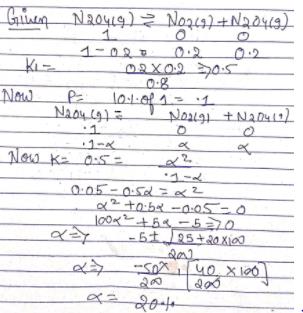
We know that the relationship between Kc and Kp is Kp = Kc (RT)Δn
What would be the value of Δn for the reaction NH4Cl (s) ⇔ NH3 (g) + HCl (g)
a)1b)0.5c)1.5d)2Correct answer is option 'D'. Can you explain this answer?
|
|
Nandini Patel answered |
The answer is d.
The relationship between Kp and Kc is
The relationship between Kp and Kc is
Kp = Kc (RT) ∆n
Where ∆n = (number of moles of gaseous products) – (number of moles of gaseous reactants)
For the reaction,
NH4C1(s) ⇆ NH3(g) + HCl(g)
∆n = 2 – 0 = 2
In the following equilibrium AB  A+ + B-
A+ + B-
AB is 10% dissociated, when [AB] = 1MQ. What is per cent dissociation if 1 M AB is dissociated in the presence of 1 M A+? - a)5.2%
- b)6.0%
- c)1.1%
- d)10.0%
Correct answer is option 'C'. Can you explain this answer?
In the following equilibrium AB  A+ + B-
A+ + B-
AB is 10% dissociated, when [AB] = 1M
 A+ + B-
A+ + B-AB is 10% dissociated, when [AB] = 1M
Q. What is per cent dissociation if 1 M AB is dissociated in the presence of 1 M A+?
a)
5.2%
b)
6.0%
c)
1.1%
d)
10.0%
|
|
Hansa Sharma answered |
The correct answer is option C
Let initially
AB = 1M
AB = A+ + B-
⇒1 - 0.1

K should remain same
AB ⇌ A+ + B-
1-x
Let initially
AB = 1M
AB = A+ + B-
⇒1 - 0.1

K should remain same
AB ⇌ A+ + B-
1-x
Kc forthe decomposition of NH4HS(s) is 1.8x 10-4 at 25°C.

If the system already contains [NH3] = 0.020 M, then when equilibrium is reached, molar concentration are

- a)a
- b)b
- c)c
- d)d
Correct answer is option 'B'. Can you explain this answer?
Kc forthe decomposition of NH4HS(s) is 1.8x 10-4 at 25°C.

If the system already contains [NH3] = 0.020 M, then when equilibrium is reached, molar concentration are

If the system already contains [NH3] = 0.020 M, then when equilibrium is reached, molar concentration are
a)
a
b)
b
c)
c
d)
d

|
Sushil Kumar answered |
NH4HS (s) ⇋ NH3 (g) + H2S (g)
Initial 1 - -
At eqm 1-x x+0.02 x
Kc = [NH3][H2S] (Since NH4HS is solid, we ignore it.)
1.8×10-4 = (x+0.02)(x)
x2+0.02x-1.8×10-4 = 0
Applying quadratic formula; x = -0.02+√{(0.02)2-4×1.8×10-4}
= 0.033-0.020/2 = 0.0065
Therefore, concn of NH3 at equilibrium = x+0.020 = 0.0265
concn of H2S at equilibrium = x = 0.0065
So, option b is correct
Initial 1 - -
At eqm 1-x x+0.02 x
Kc = [NH3][H2S] (Since NH4HS is solid, we ignore it.)
1.8×10-4 = (x+0.02)(x)
x2+0.02x-1.8×10-4 = 0
Applying quadratic formula; x = -0.02+√{(0.02)2-4×1.8×10-4}
= 0.033-0.020/2 = 0.0065
Therefore, concn of NH3 at equilibrium = x+0.020 = 0.0265
concn of H2S at equilibrium = x = 0.0065
So, option b is correct
Equilibrium constant for the reaction PCL5⇋PCL3+CL2 is 0.0205 at 230°C and 1 atmospheric pressure if at equilibrium concentration of PCL5 is 0.235 moles liter−1liter-1and that of CL2= 0.028 moleslit−1lit-1 then conc. of PCL3 at equilibrium is- a)0.0174
- b)0.174
- c)0.0348
- d)1.74
Correct answer is option 'A'. Can you explain this answer?
Equilibrium constant for the reaction PCL5⇋PCL3+CL2 is 0.0205 at 230°C and 1 atmospheric pressure if at equilibrium concentration of PCL5 is 0.235 moles liter−1liter-1and that of CL2= 0.028 moleslit−1lit-1 then conc. of PCL3 at equilibrium is
a)
0.0174
b)
0.174
c)
0.0348
d)
1.74
|
|
Mira Sharma answered |

For the following gaseous phase equilibrium,

Kp is found to be equal to Kx (Kx is equilibrium constant when concentration are taken in terms of mole fraction. This is attained when pressure is - a)1 atm
- b)0.5 atm
- c)2 atm
- d)4 atm
Correct answer is option 'A'. Can you explain this answer?
For the following gaseous phase equilibrium,

Kp is found to be equal to Kx (Kx is equilibrium constant when concentration are taken in terms of mole fraction. This is attained when pressure is
Kp is found to be equal to Kx (Kx is equilibrium constant when concentration are taken in terms of mole fraction. This is attained when pressure is
a)
1 atm
b)
0.5 atm
c)
2 atm
d)
4 atm
|
|
Preeti Iyer answered |
The correct answer is Option A.
Kp = Equilibrium constant in terms of partial pressure
Kc = Equilibrium constant in terms of concentration
Kx = Equilibrium constant in terms of mole fraction
Kp = KcRTΔn ---(1)
Kp = K * (Pt)Δn ---(2)
a) 1 atm
Given PCl5 (g) ---> PCl3 (g) + Cl2 (g)
Δn = 2 – 1
Given Kp = Kx
From (2)
Kp = Kx when PT = 1
Kp = Equilibrium constant in terms of partial pressure
Kc = Equilibrium constant in terms of concentration
Kx = Equilibrium constant in terms of mole fraction
Kp = KcRTΔn ---(1)
Kp = K * (Pt)Δn ---(2)
a) 1 atm
Given PCl5 (g) ---> PCl3 (g) + Cl2 (g)
Δn = 2 – 1
Given Kp = Kx
From (2)
Kp = Kx when PT = 1
Variation of log Kp with temperature. 1/T is given by for the equilibrium.
NH4HS (s)  NH3(g) + H2S
NH3(g) + H2S
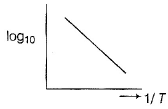 Q. The equilibrium is displaced in forward side on
Q. The equilibrium is displaced in forward side on- a)increasing temperature and decreasing pressure
- b)increasing temperature and pressure both
- c)decreasing temperature and pressure both
- d)decreasing temperature and increasing pressure
Correct answer is option 'A'. Can you explain this answer?
Variation of log Kp with temperature. 1/T is given by for the equilibrium.
NH4HS (s) NH3(g) + H2S
NH3(g) + H2S

NH4HS (s)
Q. The equilibrium is displaced in forward side on
a)
increasing temperature and decreasing pressure
b)
increasing temperature and pressure both
c)
decreasing temperature and pressure both
d)
decreasing temperature and increasing pressure

|
Sushil Kumar answered |
The correct answer is Option A.
When ammonia is added after equilibrium is established, the partial pressure of ammonia will increase.When the temperature of an endothermic reaction is increased, the equilibrium will shift in the forward direction so that the heat is absorbed which will nullify the effect of increased temperature. Hence, the partial pressure of ammonia will increase.When the volume of the flask is increased, the pressure will decrease.
When ammonia is added after equilibrium is established, the partial pressure of ammonia will increase.When the temperature of an endothermic reaction is increased, the equilibrium will shift in the forward direction so that the heat is absorbed which will nullify the effect of increased temperature. Hence, the partial pressure of ammonia will increase.When the volume of the flask is increased, the pressure will decrease.
Passage ISolid ammonium chloride is in equilibrium with ammonia and hydrogen chloride gases

0.980 g of solid NH4CI is taken in a closed vessel of 1 L capacity and heated to 275° C.Q. Percentage decomposition of the original sample is- a)24.81%
- b)6.24%
- c)3.12%
- d)12.13%
Correct answer is option 'D'. Can you explain this answer?
Passage I
Solid ammonium chloride is in equilibrium with ammonia and hydrogen chloride gases

0.980 g of solid NH4CI is taken in a closed vessel of 1 L capacity and heated to 275° C.
0.980 g of solid NH4CI is taken in a closed vessel of 1 L capacity and heated to 275° C.
Q. Percentage decomposition of the original sample is
a)
24.81%
b)
6.24%
c)
3.12%
d)
12.13%

|
Knowledge Hub answered |
The state of HCl is given wrong. It will be in gaseous state.
So, the reaction be like;-
NH4Cl(s) ⇌ NH3(g) + HCl(g) kp = 1.00×10-2 at 275° C
Kp = kc(RT)2
1.00×10-2 = kc(0.0821×548)2
Or kc = 4.94×10-6
NH4Cl(s) ⇌ NH3(g) + HCl(g)
Initial 1 - -
At eqm 1-x x x
Kc = x2
x = √(4.94×10-6)
= 2.22×10-3
Therefore, NH4Cl dissociated at eqm = 2.22×10-3 × 53.5 = 0.118
%age decomposition = 0.118/0.980×100 = 12.13%
So, the reaction be like;-
NH4Cl(s) ⇌ NH3(g) + HCl(g) kp = 1.00×10-2 at 275° C
Kp = kc(RT)2
1.00×10-2 = kc(0.0821×548)2
Or kc = 4.94×10-6
NH4Cl(s) ⇌ NH3(g) + HCl(g)
Initial 1 - -
At eqm 1-x x x
Kc = x2
x = √(4.94×10-6)
= 2.22×10-3
Therefore, NH4Cl dissociated at eqm = 2.22×10-3 × 53.5 = 0.118
%age decomposition = 0.118/0.980×100 = 12.13%
In which of the following solvents is silver chloride most soluble?- a)0.1 mol dm–3 AgNO3 solution
- b)0.1 mol dm–3 HCl solution
- c)H2O
- d)Aqueous ammonia
Correct answer is option 'D'. Can you explain this answer?
In which of the following solvents is silver chloride most soluble?
a)
0.1 mol dm–3 AgNO3 solution
b)
0.1 mol dm–3 HCl solution
c)
H2O
d)
Aqueous ammonia
|
|
Naina Bansal answered |
Silver chloride forms a soluble complex with aqueous ammonia.
AgCl + 2NH3→ [Ag(NH3)2]Cl
Consider the following solubility data for various chromates at 25°C.
Salt Ksp
 the chromate that is most suitable is?
the chromate that is most suitable is?
- a)Ag2CrO4
- b)BaCrO4
- c)PbCrO4
- d)none of these
Correct answer is option 'B'. Can you explain this answer?
Consider the following solubility data for various chromates at 25°C.
Salt Ksp

the chromate that is most suitable is?
a)
Ag2CrO4
b)
BaCrO4
c)
PbCrO4
d)
none of these
|
|
Rahul Bansal answered |
The salt with more Ksp is more soluble in water. Hence BaCrO4 is more soluble.
Consider KA, the potassium salt of a weak acid, HA. If a sample of KA is dissolved in water, with no other substances added, which of the following statements is true (approximately)?- a)[H3O+] = [OH-]
- b)[HA] = [K+]
- c)[HA] = [OH-]
- d)[H3O+] = [A-]
Correct answer is option 'C'. Can you explain this answer?
Consider KA, the potassium salt of a weak acid, HA. If a sample of KA is dissolved in water, with no other substances added, which of the following statements is true (approximately)?
a)
[H3O+] = [OH-]
b)
[HA] = [K+]
c)
[HA] = [OH-]
d)
[H3O+] = [A-]
|
|
Suresh Iyer answered |
The correct answer is option C
[HA] = [OH–]
The reaction is: A– + H2O ⇌ HA + OH–
[HA] = [OH–]
The reaction is: A– + H2O ⇌ HA + OH–
Which of the following on the addition will cause deep red colour to disappear?

- a)AgNO3
- b)HgCI2
- c)H2C2O4
- d)H2O
Correct answer is option 'A,B,C'. Can you explain this answer?
Which of the following on the addition will cause deep red colour to disappear?

a)
AgNO3
b)
HgCI2
c)
H2C2O4
d)
H2O
|
|
Neha Joshi answered |
The correct answers are option A,B,C
Because of silver salt ie . silver nitrate with powerful germicidal activity
Ag+ + SCN− → AgSCN↓
Hg2+ + SCN− → Hg(SCN)2↓
4Fe3+ + 3(COO)2−2 → 2Fe2(COO)3↓
Because of silver salt ie . silver nitrate with powerful germicidal activity
Ag+ + SCN− → AgSCN↓
Hg2+ + SCN− → Hg(SCN)2↓
4Fe3+ + 3(COO)2−2 → 2Fe2(COO)3↓
Direction (Q. Nos. 21) This section contains 2 questions. when worked out will result in an integer from 0 to 9 (both inclusive)Q. For the equilibrium in gaseous phase in 2 L flask we start with 2 moles of SO2 and 1 mole of O2 at 3 atm, 
When equilibrium is attained, pressure changes to 2.5 atm. Hence, equilibrium constant Kc is
Correct answer is '4'. Can you explain this answer?
Direction (Q. Nos. 21) This section contains 2 questions. when worked out will result in an integer from 0 to 9 (both inclusive)
Q. For the equilibrium in gaseous phase in 2 L flask we start with 2 moles of SO2 and 1 mole of O2 at 3 atm, 
When equilibrium is attained, pressure changes to 2.5 atm. Hence, equilibrium constant Kc is
When equilibrium is attained, pressure changes to 2.5 atm. Hence, equilibrium constant Kc is
|
|
Om Desai answered |
The correct answer is 4
2SO2(g) + O2(g) ⇋ 2SO3
Initial moles 2 1
At equilibrium 2 - 2x 1 - x 2x
Net moles at equilibrium = 2 - 2x + 1 - x + 2x
=(3 - x)moles
Initial:
moles = 3,
Pressure = 3 atm,
Volume = 2L,
PV = nRT
3 x 2 = 3RT -------- 1
At equilibrium
Moles = 3 - x,
Pressure = 2.5 atm
Volume = 2L
P‘V = n’RT ---------- 2
Divide eqn 2 by 1

⇒2.5 = 3 - x
⇒x = 0.5

2SO2(g) + O2(g) ⇋ 2SO3
Initial moles 2 1
At equilibrium 2 - 2x 1 - x 2x
Net moles at equilibrium = 2 - 2x + 1 - x + 2x
=(3 - x)moles
Initial:
moles = 3,
Pressure = 3 atm,
Volume = 2L,
PV = nRT
3 x 2 = 3RT -------- 1
At equilibrium
Moles = 3 - x,
Pressure = 2.5 atm
Volume = 2L
P‘V = n’RT ---------- 2
Divide eqn 2 by 1

⇒2.5 = 3 - x
⇒x = 0.5

For the equilibrium,

at 1000 K. If at equilibrium pCO = 10 then total pressure at equilibrium is
then total pressure at equilibrium is - a)6.30 atm
- b)0.63 atm
- c)6.93 atm
- d)69.3 atm
Correct answer is option 'C'. Can you explain this answer?
For the equilibrium,

at 1000 K. If at equilibrium pCO = 10 then total pressure at equilibrium is
then total pressure at equilibrium is
at 1000 K. If at equilibrium pCO = 10
a)
6.30 atm
b)
0.63 atm
c)
6.93 atm
d)
69.3 atm
|
|
Lavanya Menon answered |
C(s) + CO2(g) <=========> 2CO(g)
Kp = pCO2/pCO2
GIven Kp = 63 and pCO = 10pCO2
Putting the value of pCO in above equation,
63 = 100(pCO2)2/pCO2
Or pCO2 = 0.63
pCO = 6.3
Therefore, total pressure = 6.3+0.63 = 6.93 atm
Kp = pCO2/pCO2
GIven Kp = 63 and pCO = 10pCO2
Putting the value of pCO in above equation,
63 = 100(pCO2)2/pCO2
Or pCO2 = 0.63
pCO = 6.3
Therefore, total pressure = 6.3+0.63 = 6.93 atm
Equilibrium can be attained i- a)all types of system
- b)closed system
- c)open system
- d)isolated system
Correct answer is option 'B'. Can you explain this answer?
Equilibrium can be attained i
a)
all types of system
b)
closed system
c)
open system
d)
isolated system
|
|
Preeti Iyer answered |
The equilibrium state can only be reached if the chemical reaction takes place in a closed system. Otherwise, some of the products may escape, leading to the absence of a reverse reaction. (Note that in the diagrams under "Characteristics of Chemical Equilibrium," all reactions are in closed systems.)
Can you explain the answer of this question below:Equilibrium reactions are found in large scale in production of
- A:
ammonia
- B:
sulfuric acid
- C:
lactic acid
- D:
both A and B
The answer is d.
Equilibrium reactions are found in large scale in production of
ammonia
sulfuric acid
lactic acid
both A and B
|
|
Shreya Gupta answered |
An understanding of equilibrium is important in the chemical industry. Equilibrium reactions are involved in some of the stages in the large-scale production of ammonia, sulfuric acid and many other chemicals.
Direction (Q. Nos. 21) Choice the correct combination of elements and column I and coloumn II are given as option (a), (b), (c) and (d), out of which ONE option is correct.The progress of the reaction  with time t is shown below.
with time t is shown below.
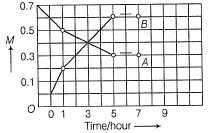
Match the parameters in Column l with their respective values in Column II.

Codes

- a)a
- b)b
- c)c
- d)d
Correct answer is option 'A'. Can you explain this answer?
Direction (Q. Nos. 21) Choice the correct combination of elements and column I and coloumn II are given as option (a), (b), (c) and (d), out of which ONE option is correct.
The progress of the reaction  with time t is shown below.
with time t is shown below.

Match the parameters in Column l with their respective values in Column II.

Codes
Match the parameters in Column l with their respective values in Column II.
Codes


a)
a
b)
b
c)
c
d)
d
|
|
Rajesh Gupta answered |
The correct answer is Option A.
Loss in concentration of A in I hour =  = 0.1
= 0.1
Gain in concentration of B in I hour = 0.2
0.2
(i) ∵0.1 mole of A changes to 0.2 mole of B in a given time and thus, n=2
(ii) Equilibrium constant,
 = 1.2mollitre−1
= 1.2mollitre−1
(iii) Initial rate of conversion of A = changes in conc. of A during I hour =
= 0.1 mol litre−1hour−1
(iv) ∵ Equilibrium is attained after 5 hr, where [B]=0.6 and [A]=0.3
 = 0.1
= 0.1Gain in concentration of B in I hour =
 0.2
0.2(i) ∵0.1 mole of A changes to 0.2 mole of B in a given time and thus, n=2
(ii) Equilibrium constant,
 = 1.2mollitre−1
= 1.2mollitre−1(iii) Initial rate of conversion of A = changes in conc. of A during I hour =

= 0.1 mol litre−1hour−1
(iv) ∵ Equilibrium is attained after 5 hr, where [B]=0.6 and [A]=0.3
Direction (Q. Nos. 1-8) This section contains 8 multiple choice questions. Each question has four
choices (a), (b), (c) and (d), out of which ONLY ONE option is correct.Q. For the following equilibrium,

Vapour density is found to be 100 when 1 mole of PCI5 is taken in 10 dm3 flask at 300 K. Thus, equilibrium pressure is- a)1.00 atm
- b)4.92 atm
- c)2.46 atm
- d)2.57 atm
Correct answer is option 'D'. Can you explain this answer?
Direction (Q. Nos. 1-8) This section contains 8 multiple choice questions. Each question has four
choices (a), (b), (c) and (d), out of which ONLY ONE option is correct.
choices (a), (b), (c) and (d), out of which ONLY ONE option is correct.
Q. For the following equilibrium,

Vapour density is found to be 100 when 1 mole of PCI5 is taken in 10 dm3 flask at 300 K. Thus, equilibrium pressure is
Vapour density is found to be 100 when 1 mole of PCI5 is taken in 10 dm3 flask at 300 K. Thus, equilibrium pressure is
a)
1.00 atm
b)
4.92 atm
c)
2.46 atm
d)
2.57 atm

|
Knowledge Hub answered |
Given, vapour pressure = 100
So, molecular weight = 200
Degree of dissociation;α = 1/(n-1)[Mtheo-Mobs/Mobs]

α = 1/(2-1)×[208.5-200/208.5]
α = 0.0425
PCl5(s) ⇌ PCl3(g) + Cl2(g)
At start 1 - - -
At eqm. (1-0.0428) (0.0428) (0.0428)
Total moles at eqm. = 1.0428
Total pressure at equilibrium; pV = nRT
p = 1.0428×0.0821×300/10
p = 2.5676 atm
So, molecular weight = 200
Degree of dissociation;α = 1/(n-1)[Mtheo-Mobs/Mobs]

α = 1/(2-1)×[208.5-200/208.5]
α = 0.0425
PCl5(s) ⇌ PCl3(g) + Cl2(g)
At start 1 - - -
At eqm. (1-0.0428) (0.0428) (0.0428)
Total moles at eqm. = 1.0428
Total pressure at equilibrium; pV = nRT
p = 1.0428×0.0821×300/10
p = 2.5676 atm
Select the correct statement (s) about the following equilibrium.
- a)At constant vapour pressure, number of molecules leaving the liquid equals the number returning to liquid from vapour
- b)This does not represent the static equilibrium
- c)This represents dynamic equilibrium and the rate of the forward and backward reactions become equal
- d)This represents dynamic as well as static equilibrium
Correct answer is option 'A,B,C'. Can you explain this answer?
Select the correct statement (s) about the following equilibrium.
a)
At constant vapour pressure, number of molecules leaving the liquid equals the number returning to liquid from vapour
b)
This does not represent the static equilibrium
c)
This represents dynamic equilibrium and the rate of the forward and backward reactions become equal
d)
This represents dynamic as well as static equilibrium
|
|
Lavanya Menon answered |
The correct answers are Options A, B and C.
During constant vapor pressure the no of molecules of H2O leaving the surface = the no of H2O molecules coming to the surface from the atmosphere. This process is dynamic as there is continuous movement of molecules.
During constant vapor pressure the no of molecules of H2O leaving the surface = the no of H2O molecules coming to the surface from the atmosphere. This process is dynamic as there is continuous movement of molecules.
At 700 K and 350 bar, a 1 : 3 mixture of N2(g) and H2(g) reacts to form an equilibrium mixture containing X (NH3)= 0.50. Assuming ideal behaviour Kp for the equilibrium reaction, 
- a)2.03x 10-4
- b)3.55x 10-3
- c)1.02 x 10-4
- d)3.1 x 10-4
Correct answer is option 'D'. Can you explain this answer?
At 700 K and 350 bar, a 1 : 3 mixture of N2(g) and H2(g) reacts to form an equilibrium mixture containing X (NH3)= 0.50. Assuming ideal behaviour Kp for the equilibrium reaction, 
a)
2.03x 10-4
b)
3.55x 10-3
c)
1.02 x 10-4
d)
3.1 x 10-4

|
Knowledge Hub answered |
The correct answer is option A
2.03x 10-4
The given equation is :-
N2(g)+3H2(g) ⇌ 2NH3(g)
Initial moles : 1 3 0
At eqm ; (1−x) (3−3x) (2x)
(let)
Total moles of equation
=1 − x + 3 − 3x + 2x = (4−2x)
Now, X(NH3) =
⇒ 2x = 2 − x
⇒ 3x = 2 ⇒ x = 0.66 =
32
Now, at equation, moles of N2= 1/3, moles of NH3 = 4/3
moles of H2 =3 − 2 = 1
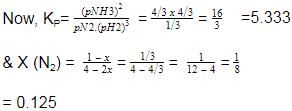
2.03x 10-4
The given equation is :-
N2(g)+3H2(g) ⇌ 2NH3(g)
Initial moles : 1 3 0
At eqm ; (1−x) (3−3x) (2x)
(let)
Total moles of equation
=1 − x + 3 − 3x + 2x = (4−2x)
Now, X(NH3) =

⇒ 2x = 2 − x
⇒ 3x = 2 ⇒ x = 0.66 =
32
Now, at equation, moles of N2= 1/3, moles of NH3 = 4/3
moles of H2 =3 − 2 = 1

Consider the following equilibrium,N2(g) + 3H2(g) 2NH3(g)
2NH3(g)
If N2(g) is added to the above mixture in equilibrium,[IIT JEE 2006]- a)the equilibrium will shift to forward direction as entropy increases in the direction of spontaneous reaction
- b)the equilibrium constant Kp increases
- c)partial pressure of NH3 as well as that of N2 increases when equilibrium is reached
- d)the equilibrium constant Kp remains constant
Correct answer is option 'C,D'. Can you explain this answer?
Consider the following equilibrium,
N2(g) + 3H2(g) 2NH3(g)
2NH3(g)
If N2(g) is added to the above mixture in equilibrium,
 2NH3(g)
2NH3(g)If N2(g) is added to the above mixture in equilibrium,
[IIT JEE 2006]
a)
the equilibrium will shift to forward direction as entropy increases in the direction of spontaneous reaction
b)
the equilibrium constant Kp increases
c)
partial pressure of NH3 as well as that of N2 increases when equilibrium is reached
d)
the equilibrium constant Kp remains constant
|
|
Raghav Bansal answered |
Partial pressure of each component in the mixture increases on increasing concentration. Also,according to Le Chatelier's principle the reaction would shift such that kp does not change.
The solubility product expression for silver(I) sulphide, using x to represent the molar concentration of silver(I) and y to represent the molar concentration of sulphide, is formulated as:- a)x2y2
- b)xy3
- c)x2y
- d)xy2
Correct answer is option 'C'. Can you explain this answer?
The solubility product expression for silver(I) sulphide, using x to represent the molar concentration of silver(I) and y to represent the molar concentration of sulphide, is formulated as:
a)
x2y2
b)
xy3
c)
x2y
d)
xy2
|
|
Om Desai answered |
The correct answer is Option C.
The ionization equilibrium of silver (I) sulfide is
Ag2S⇌2Ag+ +S2−
The solubility product expression for silver (I) sulfide is KSP[Ag+]2 [S2−].
But [Ag+]2 = x and [S2−] = y.
Hence the expression for the solubility product becomes KSP[Ag+]2 [S2−] = x2y.
The ionization equilibrium of silver (I) sulfide is
Ag2S⇌2Ag+ +S2−
The solubility product expression for silver (I) sulfide is KSP[Ag+]2 [S2−].
But [Ag+]2 = x and [S2−] = y.
Hence the expression for the solubility product becomes KSP[Ag+]2 [S2−] = x2y.
Role of NH4Cl in qualitative analysis of third group cations- a)to provide basic medium
- b)to provide acidic medium
- c)to increase the degree of dissociation of NH4OH
- d)to suppress the degree of dissociation of NH4OH
Correct answer is option 'D'. Can you explain this answer?
Role of NH4Cl in qualitative analysis of third group cations
a)
to provide basic medium
b)
to provide acidic medium
c)
to increase the degree of dissociation of NH4OH
d)
to suppress the degree of dissociation of NH4OH
|
|
Raghav Bansal answered |
The correct answer is option D
Common ion effect is observed when a solution of weak electrolyte is mixed with a solution of strong electrolyte, which provides an ion common to that provided by weak electrolyte.
The NH4OH is a weak base and it does not ionise completely. Thus, due to presence of common ion NH4+ in NH4Cl, it suppresses the ionisation of weak base NH4OH in order to decrease the OH- concentration so that higher group cations will not get precipitated.
Thus the pair NH4OH+NH4Cl shows a common ion effect.
Ammonium chloride suppresses the ionization of ammonium hydroxide
.
Common ion effect is observed when a solution of weak electrolyte is mixed with a solution of strong electrolyte, which provides an ion common to that provided by weak electrolyte.
The NH4OH is a weak base and it does not ionise completely. Thus, due to presence of common ion NH4+ in NH4Cl, it suppresses the ionisation of weak base NH4OH in order to decrease the OH- concentration so that higher group cations will not get precipitated.
Thus the pair NH4OH+NH4Cl shows a common ion effect.
Ammonium chloride suppresses the ionization of ammonium hydroxide
.
We eat a variety of foods still pH of our blood does not change every time. The reason is- a)Strong bases in the blood donot let pH change
- b)Stomach wall is resistant
- c)There are buffers in the blood which resist pH change
- d)Strong acids in the blood donot let pH change
Correct answer is option 'C'. Can you explain this answer?
We eat a variety of foods still pH of our blood does not change every time. The reason is
a)
Strong bases in the blood donot let pH change
b)
Stomach wall is resistant
c)
There are buffers in the blood which resist pH change
d)
Strong acids in the blood donot let pH change
|
|
Pooja Shah answered |
The correct answer is option C
pH of blood remains constant because of the buffer system present in the blood. Acid-base buffers confer resistance to a change in the pH of a solution when hydrogen ions (protons) or hydroxide ions are added or removed. An acid-base buffer typically consists of a weak acid, and its conjugate base (salt).It used to neutralized the extra added protons or OH- in blood.The buffer for maintaining acid-base balance in the blood is the carbonic-acid-bicarbonate buffer.So pH of blood remains even after eating spicy food.
pH of blood remains constant because of the buffer system present in the blood. Acid-base buffers confer resistance to a change in the pH of a solution when hydrogen ions (protons) or hydroxide ions are added or removed. An acid-base buffer typically consists of a weak acid, and its conjugate base (salt).It used to neutralized the extra added protons or OH- in blood.The buffer for maintaining acid-base balance in the blood is the carbonic-acid-bicarbonate buffer.So pH of blood remains even after eating spicy food.
Chapter doubts & questions for Chemical Equilibrium - Chemistry for EmSAT Achieve 2025 is part of EmSAT Achieve exam preparation. The chapters have been prepared according to the EmSAT Achieve exam syllabus. The Chapter doubts & questions, notes, tests & MCQs are made for EmSAT Achieve 2025 Exam. Find important definitions, questions, notes, meanings, examples, exercises, MCQs and online tests here.
Chapter doubts & questions of Chemical Equilibrium - Chemistry for EmSAT Achieve in English & Hindi are available as part of EmSAT Achieve exam.
Download more important topics, notes, lectures and mock test series for EmSAT Achieve Exam by signing up for free.
Chemistry for EmSAT Achieve
191 videos|265 docs|160 tests
|

Contact Support
Our team is online on weekdays between 10 AM - 7 PM
Typical reply within 3 hours
|
Free Exam Preparation
at your Fingertips!
Access Free Study Material - Test Series, Structured Courses, Free Videos & Study Notes and Prepare for Your Exam With Ease

 Join the 10M+ students on EduRev
Join the 10M+ students on EduRev
|

|
Create your account for free
OR
Forgot Password
OR
Signup on EduRev and stay on top of your study goals
10M+ students crushing their study goals daily

